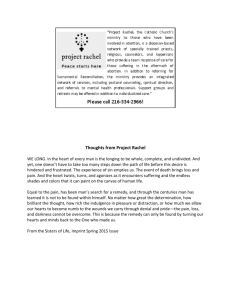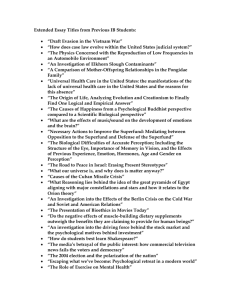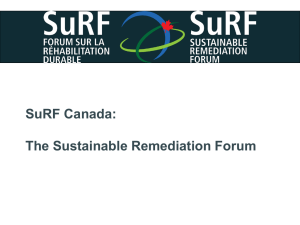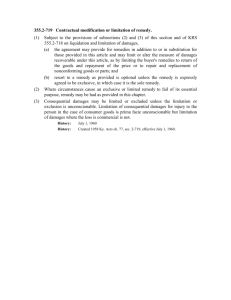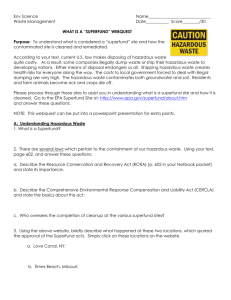M Maassssaacchhuusseettttss IInnssttiittuuttee ooff T Teecchhnnoollooggyy E
advertisement
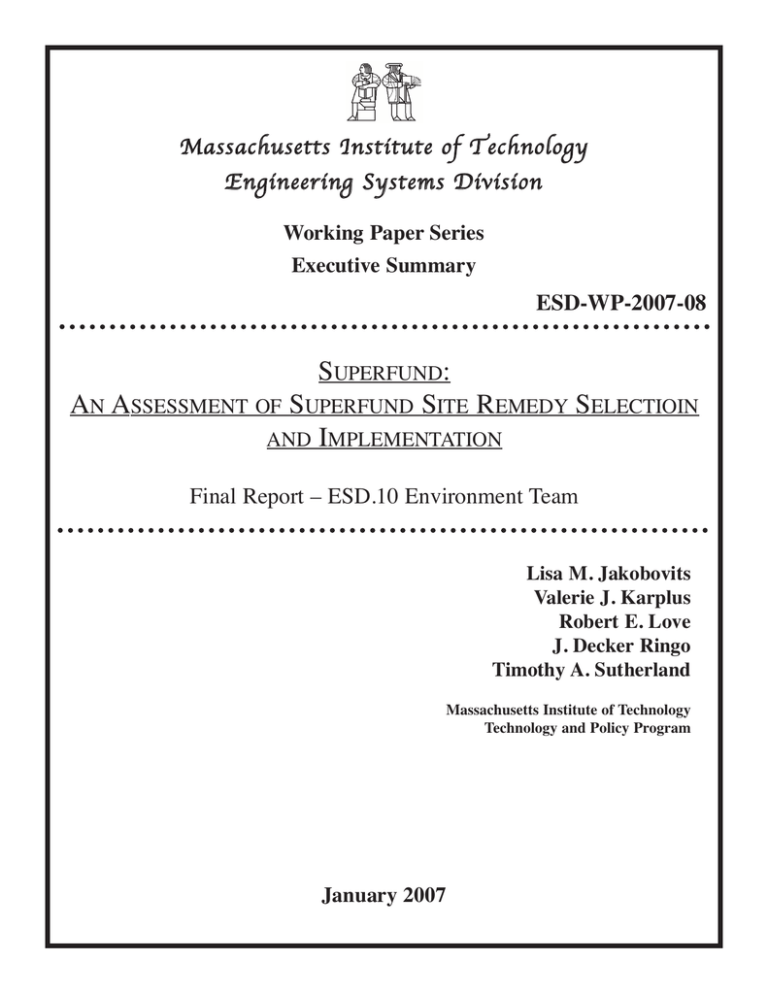
Massachusetts Institute of Technology Engineering Systems Division Working Paper Series Executive Summary ESD-WP-2007-08 SUPERFUND: AN ASSESSMENT OF SUPERFUND SITE REMEDY SELECTIOIN AND IMPLEMENTATION Final Report – ESD.10 Environment Team Lisa M. Jakobovits Valerie J. Karplus Robert E. Love J. Decker Ringo Timothy A. Sutherland Massachusetts Institute of Technology Technology and Policy Program January 2007 Executive Summary Summary Since its inception in 1980, the U.S. Environmental Protection Agency’s (EPA) Superfund Program has served as the primary mechanism for coordinating the remediation of sites contaminated with hazardous substances. Although the program has successfully overseen cleanup at hundreds of sites, experts have identified a number of weaknesses in the remedy selection and implementation processes. Our study focuses on two weaknesses that have been identified at individual Superfund sites in the previous literature: Remedy Selection: 1 • Selection of non-permanent remedies over permanent remedies Remedy Implementation: • Inconsistency and non-transparency shown in the documentation of cleanup objectives, site cleanup progress, and problems during remedy implementation2 Although these weaknesses were well documented in previous literature, our group found little evidence that the underlying cause of these weaknesses had been addressed. Our study adds to the current understanding of these weaknesses by investigating their origins using established policy and engineering systems analysis techniques. We have based our analysis on three Superfund site case studies. We offer several recommendations that address the observed weaknesses in site remedy selection and implementation. Lastly, we include suggestions for areas in which further inquiry may be useful. Remedy Selection: Balancing Stakeholder Interests and Superfund Goals The process of selecting a remedy for a Superfund site involves balancing the interests of many stakeholders to identify a set of technologies and actions that will reduce site contamination. Our team selected three Superfund sites for their diversity in size and ownership type in eastern Massachusetts to understand how stakeholder interests influence the selection of a cleanup remedy. First, our team identified which of the aforementioned problems with remedy selection persisted at each of the sites. Second, we considered the goals of three major stakeholders—the EPA, potentially responsible party (PRP), and the community—in the remedy selection process. We developed a list of the most prominent stakeholder goals, which included eliminating contamination from the site, choosing a permanent remedy, choosing a low-risk cleanup technology, cleaning the site as quickly as possible, and minimizing the cleanup cost. Third, we developed a tool to compare the prioritization of these goals at each of the three sites with the preferences of the major stakeholders. We used this tool to determine how the stakeholder interests were reflected in the selected remedy. Since the prioritization of goals differs among stakeholders, the remedy selection process involves inherent tradeoffs among stakeholder interests. Previous literature identified the failure to select permanent remedies as required by the 1986 Superfund Amendment and Reauthorization Act (SARA) as one major weakness of the Superfund program. Our inquiry focused specifically on how the selection of a permanent remedy was prioritized with respect to other important stakeholder goals. We observed that for the one site 1 U.S. Congress, Office of Technology Assessment. “Are We Cleaning Up? 10 Superfund Case Studies: Special Report.” Washington, DC: U.S. Government Printing Office OTA-ITE-362, June 1988. 2 Probst, Katherine N. Superfund’s Future: What Will it Cost? Washington DC: Resources for the Future, 2001. Executive Summary where a permanent remedy was selected, less emphasis was placed on minimizing the risk or the time required for site cleanup. At a second site, a non-permanent remedy was selected over a permanent one, reflecting a preference by the community for a quick and proven solution over a more risky long-term one. A third site classified the selected remedy as permanent when it was not. Presently, the EPA definition of “permanence” is quite vague, enabling site managers to broadly and often falsely interpret its meaning. We recommend a two-part strategy to address these problems: Recommendation #1: #1 Omit the current requirement for permanence from Superfund site remedy selection criteria. Recommendation #2: #2 Create cost incentives to encourage the selection of permanent treatment technologies. The first recommendation to omit the current permanence requirement would ensure that site managers do not misrepresent non-permanent remedies as permanent. The second recommendation envisions a greater role for the EPA in encouraging the implementation of permanent remedies, by ensuring that more effective treatment technologies will be available to site managers at a reasonable cost. Together, these actions would promote remedies that are better suited to the level and nature of site contamination, and to the interests of all stakeholders. Remedy Implementation: Improving Information Management Our study also found weaknesses in the documentation of cleanup progress during remedy implementation at all three of our sites. These weaknesses included the lack of a clear and concise statement of cleanup goals, difficultly in assessing progress towards cleanup, and a failure to follow up on previously identified problems. While some of these weaknesses had been identified in previous literature and addressed through amendments to EPA guidance documents, we found little evidence that these changes had significantly reduced the problem. We applied an established approach from the engineering systems field to develop several recommendations for improving the management and communication of information during the remedy implementation process, and considered several options for enforcing them. Recommendation #3: #3 Use “comprehensive goal statements” to articulate a complete set of objectives and targets for each site. This recommendation would provide a complete, concise description of the cleanup goals for each site that would be included in all relevant documentation throughout the remedy implementation process. Recommendation #4: #4 Use graphical metrics instead of tables to measure site cleanup progress. Currently, assessing progress towards cleanup often requires scrutiny of all the site documentation, including multiple summaries and detailed tables of data. Graphical metrics would allow cleanup progress to be communicated succinctly to all stakeholders. Moreover, they 4 Executive Summary would enable rapid identification of problems, such as failure of a remedy or incomplete monitoring. Together, recommendations #3 and #4 would provide clarity to each individual site document, consistency across all site documents, and transparency across the entire site remediation process. Recommendation #5: #5 Create a formal system for reporting problems that arise during cleanup to ensure that problems do not go unresolved. During the analysis of our sites, we noticed that several problems identified in the course of site cleanup were not addressed subsequently in the site documentation. As in the case of objective and progress reporting, effective problem management is critical to instill community confidence that a site cleanup is being properly managed. Other government organizations use formal reporting to ensure that problems do not go unresolved; we believe the Superfund program would greatly benefit from adoption of similar practices. Recommendation #6: #6 Issue mandatory changes to documentation procedures and create an EPA-level position for reviewing all documentation to ensure compliance at current and future Superfund sites. This approach would standardize reporting both within and across Superfund sites. Although fewer Superfund sites are being identified today than in Superfund’s earlier years, many of the remaining sites are large, complex, and may take decades to fully address contamination. With the longer times required for cleanup at the remaining sites, improved site documentation is perhaps even more important to ensure that unforeseen challenges do not inhibit the realization of cleanup goals. In summary, our report includes six recommendations intended to improve the availability and sound selection of effective remedies for Superfund sites and to increase the clarity and transparency of reporting progress toward remedy implementation. In remedy selection, our recommendations would reduce tradeoffs inherent in the requirement that permanent remedies be selected. In remedy implementation, our recommendations would strengthen communication of objectives, cleanup progress, and problem management, enabling Superfund to more effectively fulfill its mandate of reducing threats to human health and the environment. 5
